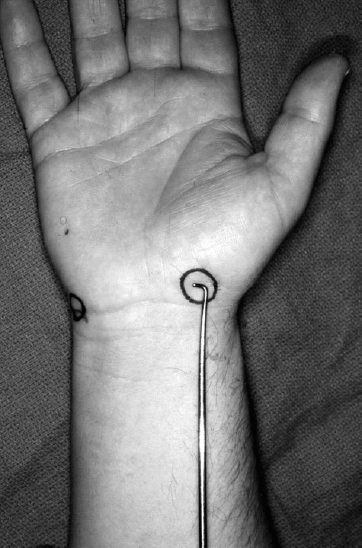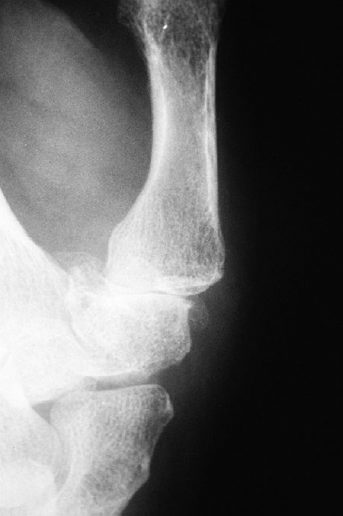31
Flexor Carpi Radialis Tunnel Syndrome
Kevin D. Plancher
History and Clinical Presentation
A 45-year-old right hand dominant woman with a previous history of carpometacarpal (CMC) arthritis presents with swelling over the volar radial side of the wrist. The patient reports she played two sets of tennis and was unable to move her wrist back and forth.
Physical Examination
The patient has tenderness directly over the flexor carpi radialis (FCR) at the wrist crease (Fig. 31–1). The Allen’s test was normal and a Tinel’s and nerve compression tests were negative.
PEARLS
- Isolated FCR tendinitis is rare
- FCR tendonitis is often seen secondary to CMC arthritis
PITFALLS
- Be aware of possibility of intraarticular injection of Marcaine into radial artery
- Rupture of the FCR tendon is possible with an injection. It can be avoided by using an orthoplast splint for 10 days postinjection.

Figure 31–1. Clinical hand that demonstrates location of tenderness over the flexor carpi radialis (FCR).

Diagnostic Studies
Anteroposterior (AP) and lateral oblique and Robert’s view (hyperpronated AP of the thumb) show abnormalities of the CMC joint (Fig. 31–2).
Differential Diagnosis
Scaphotrapezial arthritis
Scaphoid nonunions
Basal joint arthritis of the thumb
Linberg’s syndrome
Volar ganglion
FCR tendonitis
Diagnosis
Flexor Carpi Radialis (FCR) Tendinitis
Repetitive wrist motions experienced by some athletes can lead to a stenosis and synovitis within the fibroosseous tunnel containing the FCR.
The FCR passes through a synovial tunnel bordered by the scaphoid tuberosity, trapezial ridge, and the transverse carpal ligament (Fig. 31–3). Within the tunnel, the tendon occupies 90% of the available space. As the tendon enters this tunnel, it deviates 30 degrees dorsally over the volar pole of the scaphoid to insert at the base of the second and third metacarpals and provides a slip to the trapezial ridge. Weeks has suggested that this angulation may create mechanical irritation and predispose the athlete to tenosynovitis.










